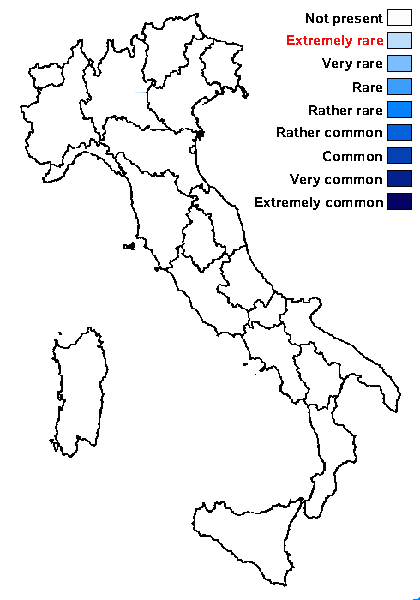Endohyalina interjecta (Müll. Arg.) Giralt
in Giralt & al., Mycol. Progr., 9, 1: 45, 2010. Basionym: Buellia interjecta Müll. Arg. - Flora, 55: 499, 1872
Synonyms: Lecidea interjecta (Müll. Arg.) Stizenb.; Rinodina interjecta (Müll. Arg.) H. Mayrhofer, Scheid. & Sheard
Distribution:
Description: Thallus crustose to subsquamulose, episubstratic, 0.4-0.6 mm thick, medium to dark brown, without a distinct prothallus, the areoles scattered, flat. Medulla I-, with crystals of two types visible under polarized light: a) small crystals dissolving in K and giving a K+ yellowish and P+ yellow solution, and, b) larger crystals not soluble in K. Apothecia lecideine, subimmersed to adnate, 0.2-0.5 mm across, with a convex, dark brown to black disc and a thin, finally excluded proper margin. Proper exciple 10-20 μm wide, brown in outer part, paler within, Aethalea-type; epithecium dark brown, N-, K-; hymenium colourless, 60-80 μm high, not inspersed with oil droplets; paraphyses 1.5-2.5 μm thick at mid-level, the apical cells (4-)5-6 μm wide; hypothecium brown, 150-200 μm high, forming a stipe. Asci 8-spored, clavate to cylindrical-clavate, the apical dome K/I+ dark blue with a pale, conical-pointed apical cushion (axial mass), the wall I-, but the thin outer gel I+ blue, Bacidia-type. Ascospores 1-septate, pigmented, ellipsoid, 10-12(-14) x 4.5–5.5 μm, Dirinaria-type, the wall microrugulate at very high magnification, the spore-ends paler, the torus developed in mature spores, with ontogeny of type B (apical thickenings visible before the insertion of the septum). Pycnidia black, immersed. Conidia bacilliform, 5-6 x c. 1 μm. Photobiont chlorococcoid. Spot tests: cortex K-, C-, KC-, P-; medulla (microscopic section, reactions very faint) K+ weakly yellow, C-, KC-, P+ weakly yellow. Chemistry: not known, perhaps with atranorin and diploicin in the medulla.Note: a poorly known species, only known from the type locality in the mountains near Genève (France), growing on granitic boulders among thalli of Rhizocarpon geographicum. To be looked for in the Italian Alps.
Growth form: Crustose
Substrata: rocks
Photobiont: green algae other than Trentepohlia
Reproductive strategy: mainly sexual
Poorly known taxon in need of further study

Predictive model
Growth form: Crustose
Substrata: rocks
Photobiont: green algae other than Trentepohlia
Reproductive strategy: mainly sexual
Poorly known taxon in need of further study

Predictive model
 Index Fungorum
Index Fungorum
 GBIF
GBIF

